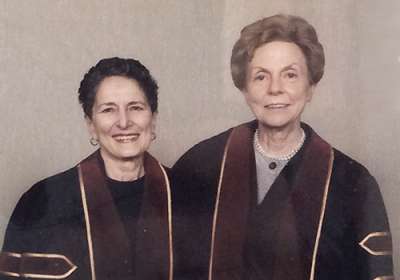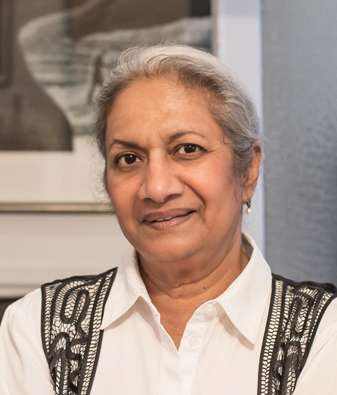September 8, 2021 | Alumni
The alumni whose innovative courses ignited women’s studies 50 years ago at U of T
By Peter Boisseau

Ceta Ramkhalawansingh (DCS 1974, BA 1977 NEW, MA 1980) (at top centre) leading a women’s studies class at U of T in 1975. Photo by University of Toronto Archives/ Robert Lansdale.
The story behind one the oldest women’s studies programs in Canada begins with the tale of two courses launched 50 years ago in the face of daunting odds and withering skepticism.
Women’s studies became part of the curriculum in 1971 when history professors Natalie Davis (Hon DLitt 1991) and Jill Conway (Hon LLD 1984) began co-teaching “History of Women,” while undergrad Ceta Ramkhalawansingh (DCS 1974, BA 1977 NEW, MA 1980) played an instrumental role in a collective that started “Women in the Twentieth Century,” one of the first interdisciplinary courses at U of T.
“It's a story about years of caring, collective labour in the face of and despite obstacles, to move from these courses into a fully fledged undergraduate program in 1974,” says Alissa Trotz, director of the Women & Gender Studies Institute.

“That’s why our 50th anniversary in a sense begins in 2021 with the first courses and then culminates in 2024. It has been a process from which we can learn so much, a process that is still unfolding in exciting new directions.”
The popularity of those early courses largely silenced skeptics and demonstrated a groundswell of demand.
“A few male faculty and colleagues had their doubts there was enough material to support a course, and whether this could be a significant intellectual contribution to the field. But we didn't care what they thought,” says Davis, professor emerita at U of T.
"The women just felt: Here we are, now it's our turn."
Here we are, now it's our turn
Enrolment for the history department course far exceeded expectations and a series of public lectures offered by the collectively taught interdisciplinary course drew thousands to hear noted feminists such as journalist June Callwood (Hon DSacLtt 1988 TRIN, Hon LLD 1988), writer Margaret Atwood (BA 1961 VIC, Hon DLitt 1983, Hon DSacLitt 1987 VIC), who earned her bachelor of arts from U of T in 1961 as a member of Victoria College, and future Supreme Court judge Rosalie Abella (BA 1967 UC, LLB 1970, Hon LLD 1990), who earned her bachelor of arts from U of T in 1967 as a member of University College.
Politics kept interaction between the courses to a minimum. Some considered the interdisciplinary course with its uncredentialed teachers too radical, while many of the students and activists behind the interdisciplinary course viewed the history course with suspicion for its ties to the University establishment.
But in tandem, they helped achieve the same goal.

“The women’s studies program would not have happened without the advocacy around the interdisciplinary course, and the fact we demonstrated such great public interest,” says Ramkhalawansingh, who earned her bachelor of arts in economics and political science as a member of New College in 1972, earned diplomas in 1974 and 1976 from what is now the Dr. Eric Jackman Institute of Child Study, and received a master’s degree from the Ontario Institute for Studies in Education in 1980.
“The history course was also significant because it was taught by two formidable scholars in their own field, which certainly gave a lot of credibility to what was happening in the interdisciplinary studies course.”
After a minor in women's studies was approved in 1974, the Women's Studies Program at New College added major and specialist degrees in 1980 before becoming the Institute for Women & Gender Studies in 1999. It was renamed the Women & Gender Studies Institute (WGSI) in 2005 when it earned departmental status. True to its interdisciplinary roots, WGSI now collaborates with 33 other departments and units and seven faculties, more than any other program.
The ripple effect was undeniable, helping in the creation of women’s studies programs around the world
The ripple effect from those first courses and the program beyond U of T was also undeniable. Course materials and syllabi — largely assembled from scratch by faculty and students — were widely shared, helping in the creation of women’s studies programs across North America and around the world.
Davis helped establish women’s studies programs at UC Berkeley, Princeton University and the University of Oxford during a series of teaching appointments. Conway was appointed U of T’s first female vice-president in 1973 and continued teaching the history course until becoming president of Smith College in Massachusetts in 1975.
After completing her residency requirements for a PhD, Ramkhalawansingh joined Toronto City Hall to help develop its equity and diversity programs. In 2020, she established a scholarship for undergraduate students enrolled in a major or specialist program in women and gender studies or in Caribbean studies at U of T.
Tutorial assistants and students from those early courses went on take leadership roles in women’s studies programs across Canada and champion equity in government and the private sector.
Linda Kealey (BA 1969 SMC, BLSc 1970, MA 1974, PhD 1982), who earned her bachelor of arts in sociology as a member of St. Michael’s College in 1969, a bachelor of library sciences in 1970, a masters of arts in 1974 and a PhD in 1982 from U of T, developed women’s history courses at the University of New Brunswick (UNB) and helped found the women’s studies program at Memorial University in the early 1980s.
“There is no question the pioneering course in women’s history at U of T combined with Conway’s encouragement and my involvement in the women’s movement shaped my career,” says Kealey.
“I have always taken seriously the obligation to be a mentor and to contribute to the field,” adds Kealey, professor emerita at UNB.
We had no idea how transformative this would become — even in our wildest dreams
Monika Simon (BA 1974 WDW) recalls enrolling in the new interdisciplinary course because it sounded intriguing.
“At the time, I didn’t have a sense of being part of something larger but later I realized the course gave me a broader perspective of the role of women in the world,” says Simon, a retired business executive who earned her bachelor of arts in political science from Woodsworth College in 1974.
“This knowledge allowed me to confidently work in different jobs where most of the time I was the only woman executive in the office and board rooms.”
Ramkhalawansingh says she feels a sense of pride when she looks back on the campaign to establish the interdisciplinary course and the way women’s studies has evolved since then.
"I'm thrilled we did this. And certainly, when we set out in 1970, we had no idea how transformative this would become — even in our wildest dreams."

